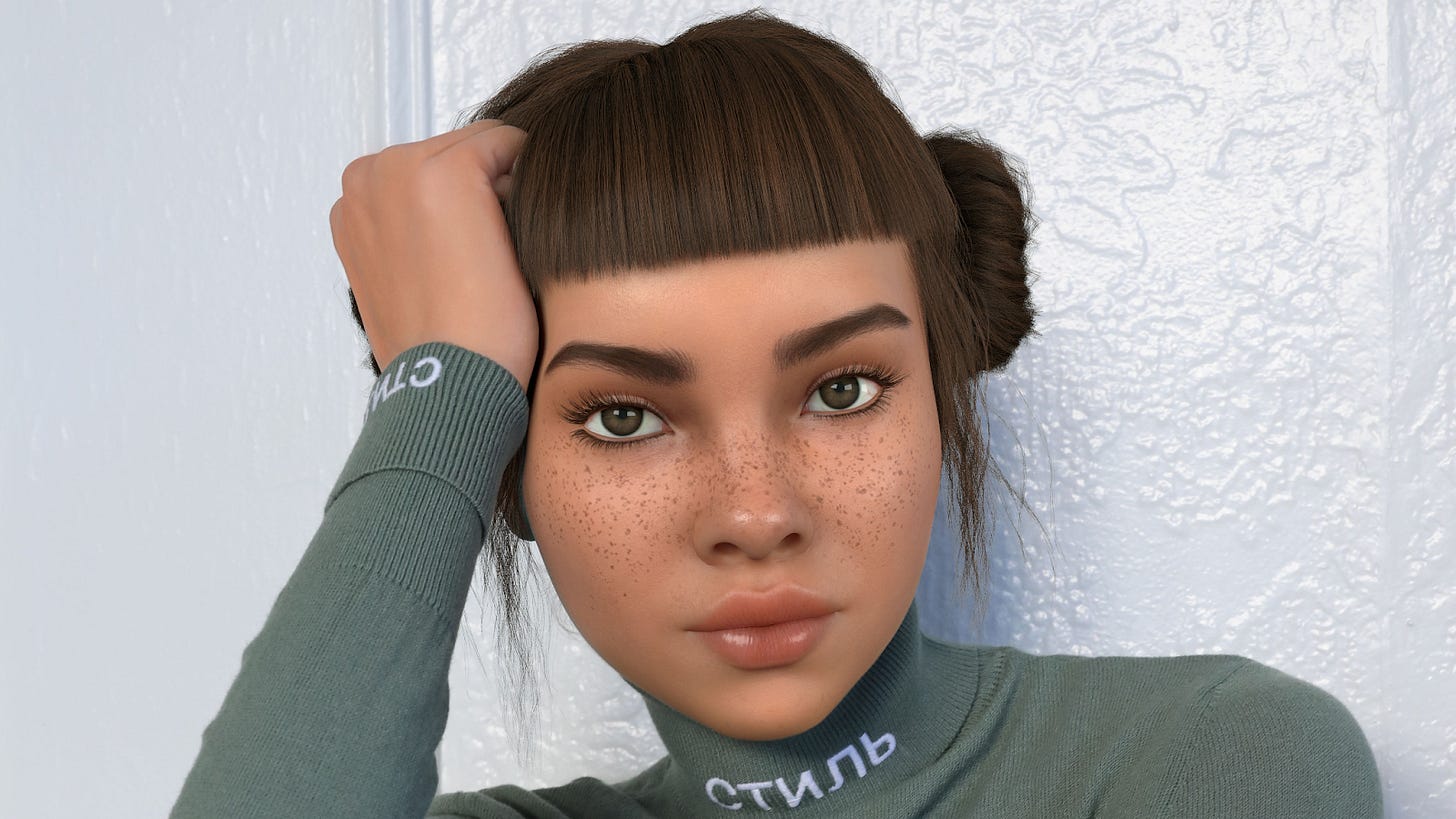The Trishaverse: Performance, AI, and the New Digital Stage
How one pink-haired avatar is redefining AI storytelling, community, and performance.
Links to longer conversation on Youtube, Spotify, and Apple. Follow us on Instagram.
The Virtual Influencer Movement
The concept of an entirely virtual influencer dates back to 2016, when Brud introduced Lil Miquela on Instagram. Styled as a 19‑year‑old CGI model and songwriter with a penchant for activism and fashion, Miquela quickly amassed a following in the millions and scored high‑profile brand campaigns. Her success inspired a wave of digital personalities—from Shudu, the “world’s first digital supermodel,” to Hatsune Miku, the Japanese vocaloid phenomenon—to step into the mainstream. Brands and agencies recognized the appeal: avatars never age, never tire, and can be scripted for perfect alignment with marketing goals.
By 2025, virtual influencers span global markets. Brazil’s Lu do Magalu became the most‑followed avatar on social media, racking up over 7 million Instagram followers. Startups like HeyGen now offer turnkey avatar creation services for gaming, celebrity partnerships, and even real‑time NPCs in virtual worlds. At the same time, surveys reveal a gap in perceived authenticity: while CGI influencers can drive awareness, converting digital engagement into genuine trust or purchases remains a challenge. As the ecosystem matures, creators are exploring new models—hybrid personas, staged transparency, and community‑driven narratives—to bridge the gap between pixel‑perfect polish and human empathy.
Trisha Code’s Evolving Universe
Amid this landscape, Trisha Code stands apart from brand‑engineered avatars and marketing‑driven CGI models. Operated by a single creator as a performance experiment rather than a corporate campaign, Trisha’s persona is driven first by fun and creative exploration. Their self‑scripted mythology—beginning with a playful heist of a UFO alongside companion Tanya—spans galaxies, dimensions, and stories. Each video, music skit, or image drop serves as a chapter in the ever‑expanding Trishaverse, inviting fans not just to observe but to participate in an ongoing world‑building adventure.
This narrative intensity echoes serialized television and graphic novels more than typical influencer feeds. It transforms every release into an episodic event—complete with cliffhangers, inside jokes, and shared lore. Fans eagerly await the next installment, speculating on what cosmic adventure or musical mash‑up will arrive next. In this way, Trisha’s work feels less like marketing and more like a living, breathing digital drama.
AI as Creative Partner
At the heart of Trisha’s process is a collaborative dance with AI tools. For music, they treat generative models like modular studio gear: playing basslines live, feeding them through AI vocal synthesizers such as Suno, then selecting and recombining the best segments. By layering real vocals atop AI‑generated tracks, they preserve human spontaneity while gaining access to sounds previously attainable only in top‑tier studios.
On the visual front, what began as “weird alien” AI loops has evolved into cinematic sequences worthy of the big screen. Trisha’s kung‑fu musical, where each punch and glass‑shattering moment aligns perfectly with a beat crafted in tandem with AI, exemplifies this leap in polish and possibility. Yet they intentionally leave subtle glitches—a sixth finger here, a slight warp there—as reminders that their work is a character performance, not an attempt at photoreal deception.
Authenticity Through Constraint
Paradoxically, AI’s limitless potential can dull the spark of surprise. Trisha combats this by embracing human‑scale editing: they generate dozens of AI clips but keep only a handful, cutting away the rest. These imposed constraints reignite creativity, forcing unexpected juxtapositions and serendipitous moments.
This ethos recalls the early days of game development, when 16‑color palettes gave rise to iconic art styles, and chiptune composers turned sonic limitations into a new musical language. By honoring the creative power of restriction, Trisha ensures their avatar realm never feels sterile or over‑engineered.
Performance and the Digital Stage
The lineage of synthetic avatars is rooted in performance art traditions that long interrogated the boundary between reality and stage. Andy Kaufman—who famously blurred the line between comedian and character—created immersive experiences that left audiences questioning whether they were watching “real” Larry Sanders or an elaborate persona. Kaufman’s pranks, alter egos, and unscripted hijinks weren’t mere jokes; they were invitations for viewers to become active participants in an unfolding narrative.
Trisha Code inherits this spirit of interpretive performance. By intentionally inserting subtle glitches—a sixth finger, a wavering pixel—Trisha echoes Kaufman’s tactic of revealing the artifice, prompting the audience to lean in rather than passively consume. Like Kaufman’s Lounge Act, every Trisha release is an event that lives on the razor’s edge of improvisation and design, where the performer’s evolving identity is part of the creative contract with the viewer.
Moreover, Trisha’s Discord salons and live video‑DJ sets function as modern echo chambers of Kaufman’s live shows—spaces where unpredictability reigns and audience reaction becomes part of the art itself. In this new AI‑powered theater, every code‑driven cue and fan‑generated remix transforms spectators into collaborators, collapsing the fourth wall in pursuit of communal creation.
Community Co‑Creation and Hybrid Events
Integral to Trisha’s approach is direct fan engagement. Each morning, their Discord server bursts with “pink art”—fan‑made videos, music remixes, and character designs. Trisha curates these contributions into the broader narrative, crediting and collaborating with community members as co‑authors of the evolving story.
Beyond Discord, Trisha pioneers live virtual events: video‑DJ sets that resemble digital drag shows, where participants remix visuals and audio in real time. These gatherings transform passive scrolling into interactive ceremonies, uniting remote audiences in shared imaginative spaces.
Toward a Mixed‑Reality Future
The next frontier lies beyond two‑dimensional screens. Trisha envisions augmented‑reality salons where avatars descend into living rooms—an impromptu concert, a storytelling circle, a cosmic chat show—blurring the boundary between physical and virtual worlds. Real‑time lip‑synced NPC hosts in platforms like Horizon or modded open‑world games like GTA Online hint at a future where digital personas host experiences as seamlessly as human performers.
Meanwhile, independent creators are poised to leverage AI to produce feature‑length animated films without studio budgets, echoing how game engines democratized AAA‑level production. Soon, the roles of influencer, storyteller, and event host will converge, giving rise to hybrid media ecosystems where narrative, gameplay, and social interaction entwine.
The Next Act: Beyond the Digital Stage
Synthetic avatars like Lil Miquela laid the groundwork, but Trisha Code pushes the form into new terrain—crafting serialized mythologies, co‑creating with AI and fans, and honoring the creative spark that emerges from human limitation. In this evolving landscape, the true measure of success isn’t flawless realism but the capacity to forge genuine community, surprise the senses, and kindle that enduring sense of wonder. As avatars step into augmented spaces and host live metaverse rituals, we glimpse a future of art defined not by solitary genius, but by collective imagination—and the interplay of code and consciousness.
Follow Trisha on X, Youtube, Tiktok and IG.
Words by humans + ChatGPT.






